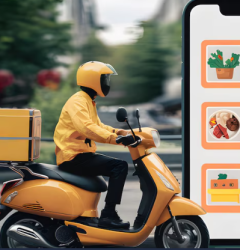26 Sep

In today’s fast-paced digital world, mobile commerce is rapidly becoming the norm. As more consumers turn to their smartphones for shopping, businesses must adapt their delivery systems to meet this growing demand. A mobile-friendly delivery system is no longer just a nice-to-have; it is essential for improving customer experience and driving sales. In this blog, we will explore the benefits of having a mobile-friendly delivery system and provide best practices for optimizing your delivery processes for mobile users.
The Rise of Mobile Commerce
Mobile commerce, or m-commerce, has surged in popularity over the past few years. With smartphones now integral to our daily lives, consumers increasingly prefer shopping on their devices. According to recent studies, mobile commerce is projected to account for over 70% of total e-commerce sales in the coming years. This trend means that businesses must ensure their delivery systems are optimized for mobile to keep pace with customer expectations.
Benefits of a Mobile-Friendly Delivery System
A mobile-friendly delivery system offers several key benefits that can enhance both customer satisfaction and business performance:
1. Improved Customer Engagement: A seamless mobile experience allows customers to browse and order easily, leading to increased engagement and brand loyalty..
2. Higher Conversion Rates: Simplifying the checkout process on mobile devices can reduce cart abandonment rates, resulting in more completed purchases.
3. Enhanced Customer Satisfaction: Providing real-time tracking and easy access to delivery information on mobile devices keeps customers informed and satisfied with their service.
4. Broader Audience Reach: A mobile-friendly delivery system enables businesses to attract a wider audience, including those who primarily use their smartphones for online shopping.
Key Features for Mobile Optimization
To create a mobile-friendly delivery system, consider incorporating the following features:
a. Responsive Design: Ensure your website and delivery platform are responsive, adjusting seamlessly to different screen sizes and orientations.
b. Simplified Checkout Process: Streamline the checkout experience by minimizing the number of steps required to complete an order and offering guest checkout options.
c. Mobile Tracking Options: Allow customers to easily track their orders in real-time via mobile-friendly interfaces, providing transparency and peace of mind.
Best Practices for Implementation
When optimizing your delivery system for mobile users, keep these best practices in mind:
a. Test Across Devices: Regularly test your delivery platform on various devices to ensure compatibility and functionality.
b. Focus on Speed: Optimize loading times, as slow websites can lead to high bounce rates and lost sales. Aim for fast, efficient mobile experiences.
c. Gather Feedback: Encourage customers to share their experiences using your mobile delivery system, and use this feedback to make necessary improvements.
d. Stay Updated: Keep up with the latest trends and technologies in mobile commerce to continuously enhance your delivery system.
Conclusion
In a world where mobile shopping is becoming the standard, having a mobile-friendly delivery system is crucial for business success. By improving customer engagement, boosting conversion rates, and enhancing overall satisfaction, a mobile-optimized approach can give your business a competitive edge. By implementing the key features and best practices outlined in this blog, you can ensure your delivery system meets the needs of today’s mobile-savvy consumers.
For more insights on optimizing your delivery services, visit Zeew and discover how our solutions can help your business thrive in the mobile marketplace.







